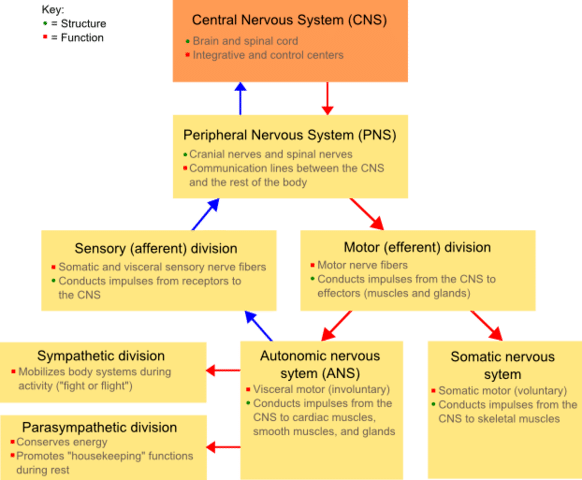The nervous system helps the organisms of the body to feel the pinch of life, and it functions via signal transmitting throughout the body to regulate its motions and other activities. The nervous system consists central processing unit/s (brain and spinal cord) which is known as Central Nervous System and the Peripheral Nervous system. The two major components of peripheral nervous system are somatic and autonomic nervous system which have the capability to control the movements of the muscles voluntarily. This discussion consists the most important and interesting differences exhibited between somatic and autonomic nervous systems.
Somatic Nervous System
Voluntary nervous system is also called as somatic nervous system. The function of somatic nervous system is to control and manage the movements of the skeletal muscles voluntarily. There are efferent nerves located in somatic nervous system to stimulate muscle contractions. All the voluntary movements in the skeletal muscles are managed by somatic nervous system. However, the reflex arcs are not managed by this system. It is very necessary to consider the pathway of the nerve signals where those begin at upper motor neurons in the precentral gyrus. The initial stimulus from the precentral gyrus (acetylcholine) is transferred through the upper motor neuron and cortico spinal tract. Then, it proceeds down through axons and finally reaches the skeletal muscle at the neuromuscular junction. At this junction, the release of acetylcholine from the terminal knobs of the axon takes place and nicotinic acetylcholine receptors of skeletal muscles relay the stimulus to contract the whole muscle.
Autonomic Nervous System
Autonomic nervous system (ANS) is also called or known as the visceral or involuntary nervous system that manages the most important muscular movements to sustain the life of an animal. Contraction of cardiac muscles to beat the very important heart, most parts of the digestive tract, regulation of respiratory function, maintenance of the size of pupil, and sexual stimulation are some of the very main functions performed by the autonomic nervous system. Part from the fact that autonomic nervous system controls involuntary actions; respiration can be managed with some consciousness. Depending up on the function of autonomic nervous system, there are two main subsystems known as afferent (sensory) and efferent (motor). The presence of both excitatory and inhibitory synapses manages the proper functionality of the autonomic nervous system in the body of animals. Sympathetic and Parasympathetic nervous systems are the two major functional modules of the autonomic nervous system.
What is the difference between Somatic and Autonomic Nervous System?
- Somatic nervous system can be voluntarily manageable whereas the autonomic nervous system is involuntarily.
- Autonomic nervous system is responsible for more muscular movements than somatic nervous system would manage.
- as compare to the somatic nervous system the functionality of the autonomic nervous system is more complex
- In vertebrates, somatic nervous system involves excitatory neurotransmitters while autonomic nervous system has both excitatory and inhibitory neurotransmitters.
- Autonomic nervous system acts on smooth muscles, cardiac muscles, and glands whereas somatic nervous system acts always on skeletal muscles.
- Somatic nervous system needs only one efferent neuron while Autonomic nervous system should have two efferent neurons and ganglia to transmit a signal.


